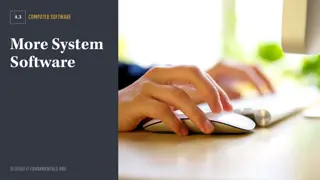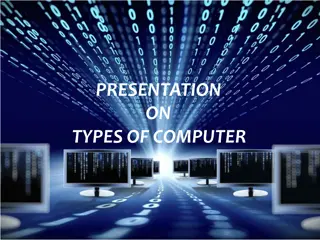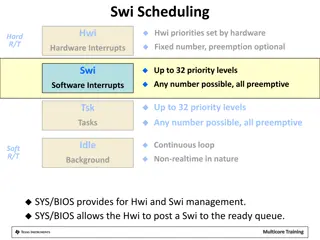Understanding the Basics of BIOS in Computers
BIOS (Basic Input Output System) is a crucial piece of software that serves as an intermediary between a computer's hardware and the operating system. It plays a fundamental role in facilitating communication and interaction between the hardware components and software applications. This article delves into the significance of BIOS, its various types such as motherboard ROM BIOS and adapter BIOS, and how it enables the hardware to interact with the operating system through standardized routines. Gain a comprehensive understanding of BIOS and its intricate relationship with the computer system.
Download Presentation

Please find below an Image/Link to download the presentation.
The content on the website is provided AS IS for your information and personal use only. It may not be sold, licensed, or shared on other websites without obtaining consent from the author. Download presentation by click this link. If you encounter any issues during the download, it is possible that the publisher has removed the file from their server.
E N D
Presentation Transcript
Introduction to BIOS Prof. Shamim Ahmad Hakim Deptt. of Computer Science Government Degree College Kulgam J&K-192231 (Class:- 1st Semester)
Computer A device that computes, especially a programmable machine that performs high-speed mathematical or logical operations or that assembles, stores, correlates, or otherwise processes information or one who computes. Computer is a machine for manipulating according to a list of instructions. electronic data
A computer takes many physical forms. Early electronic computers were the size of a large room, consuming as much power as several hundred modern personal computers. Today, computers can be made small enough to fit into a wrist watch and be powered from a watch battery. Society has come to recognize personal computers and their portable equivalent, computer, as icons of the information age; they are what most people think of as "a computer". the laptop
block diagram of a digital computer block diagram of a digital computer block diagram of a digital computer block diagram of a digital computer
Inside every PC there is BIOS, which stands for Basic Input Output System. In a nutshell, BIOS is software that interacts between a computer s hardware and the operating system and software applications.
There are several types of BIOS', ranging from the motherboard ROM BIOS to adapter BIOS' such as video BIOS, drive controller BIOS, network adapter BIOS, SCSI adapter BIOS, etc...
These BIOS' are the lowest level of software in a computer providing a set of small programs or software routines that allow the hardware of a computer to interact with the operating system by a set of standard calls.
I hope to provide a thorough understanding of how the BIOS works and leave you with a better understanding of its interworking. At the same time, I hope to show how complex BIOS is in relation to its relationship with the operating system and the software applications you use every day.
BIOS The System, usually referred to as BIOS, is software stored on a small memory chip on the motherboard BIOS is sometimes incorrectly referred to as the Basic Integrated Operating System. Basic Input Output
What is the BIOS Used For? BIOS instructs the computer on how to perform a functions such as self test) , keyboard control. number POST (power on booting of basic and BIOS is also used to identify and configure the hardware in a computer such as the hard drive, floppy drive , optical drive, CPU, memory etc.
BIOS software is stored on a non-volatile ROM chip on the motherboard. specifically work with each particular model of interfacing with devices that make up the complementary chipset of the system. It is to designed computer, various
The Basic Input/output System (BIOS), also known as the system BIOS or ROM BIOS defining a firmware interface programmed at the manufacturing time). The fundamental purposes of the BIOS is to initialize and test the system hardware components, and to load an operating system or other program from a mass memory device. (only once
If the necessary hardware is detected and found to be operating properly, the computer begins to Boot. If the hardware is not detected or is found not to be operating properly, the BIOS issue an error message which may be text on the display screen and/or a series of coded beeps, depending on the nature of the problem. Since POST runs before the computer's video card is activated, it may not be possible to progress to the display screen. The pattern of beeps may be a variable numbers of short beeps or a mixture of long and short beeps, depending on what type of BIOS is installed.
The messages about the nature of the problem detected. For example, if the keyboard is not detected, a particular pattern of beeps will inform you of that fact. An error found in the POST is usually fatal (that is, it causes current program to stop running) and will halt the boot process, since the hardware checked is absolutely essential for the computer's functions. patterns of beeps contain
In modern computer systems, the BIOS contents are stored on an EEPROM Chip so that the contents can be rewritten without removing the chip from the motherboard. This allows BIOS software to be easily upgraded to add new features. EEPROM (electrically erasable programmable ROM) A type of programmable memory (ROM) that can be erased or updated using electrical signals, a process often performed remotely. read-only
BIOS Availability modern computer contain BIOS software. BIOS access and configuration on PC systems is independent of any operating system because the BIOS is part of the motherboard hardware. It doesn't matter if a computer is running Windows 7, Windows Vista, Windows XP, Linux, UNIX, or no operating system at all - BIOS functions outside of the operating system environment dependent upon it. All motherboards and is no way
Here is basic functions of what is happening Power is applied to the computer Bootstrap POST ( power on self test) Booting Looking for the Operating System
Power is applied to the computer When power is applied to the system and all output voltages from the power supply are good, the power supply will generate a power good signal received by timer. When the timer receives this signal, it stops forcing a reset signal to the CPU and the CPU begins instructions. which motherboard is the processing
Bootstrap The very first instruction performed by a CPU is to read the contents of a specific memory address that is pre- programmed into the CPU. The code that the processor reads is actually a jump command (JMP) telling the processor where to go in memory to read the BIOS ROM
POST Abbreviated as POST, the Power on Self Test is the initial set of diagnostic performed by the computer when powered on. Tests that fail are relayed to the user via the use of POST Codes ,Beep Codes or on-screen POST error immediately after the computer powers on. tests messages
The POST is handled by the system's BIOS. When power is turned on, POST (Power-On Self-Test) diagnostic testing sequence that a computer's basic input / output system (or "starting program") runs to determine if the computer keyboard, random memory, disk drives, and other hardware are working correctly. is the access
Booting Restarting a Computer or its operating system software. It is of two types 1. Cold booting: when the computer is started after having been switched off. 2. Warm booting: operating system (without being switched off) after a system crash or 'freeze. when the alone is restarted
Both types of booting clear out (for the time being) the bombs, memory other idiosyncrasies operating system. The term boot is used to describe the process taken by the computer when turned on, that loads the operating system and prepares the system for use. The first part of the boot process is controlled by BIOS and begins after the POST. Eventually, BIOS hands the boot process over to the master boot code. bugs, and the conflicts, of























